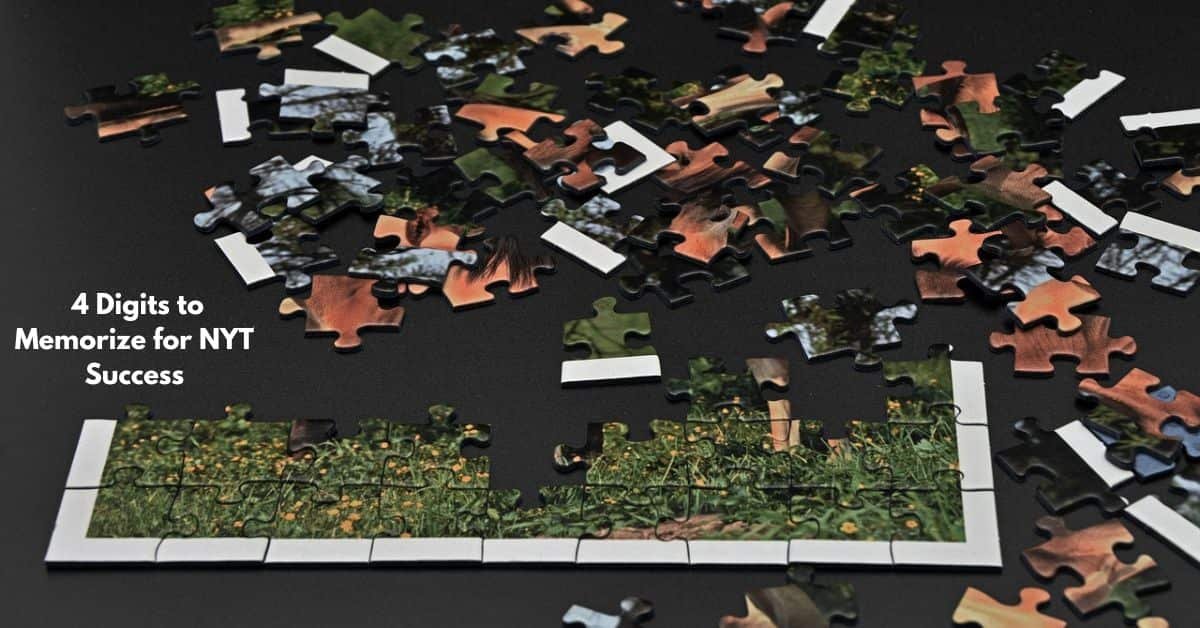Introduction to the New York Times
For millions worldwide, reading the New York Times every day is a daily ritual rather than just a newspaper. It’s an institution. Considering its lengthy history and stellar journalism reputation, readers’ desire to understand every facet of this cherished magazine makes sense. But what if you could use just four basic numbers to navigate its complex structure? Imagine surfing among sections with ease, being aware of the exact moment when your favorite articles appear in print, or becoming an expert in the enigmatic world of crossword puzzles. You can crack that code and improve your NYT experience. Prepare to dig into the numbers that have the power to change the way you interact with one of the most esteemed periodicals!
The Importance of Memorizing 4 Digits
Learning four significant numbers by heart will change how you interact with the New York Times. It involves delving deeper into an information-rich world rather than focusing only on statistics.
These numbers serve as shortcuts, pointing to each issue’s key points. They simplify your reading so you can easily navigate the different sections without getting overwhelmed.
When you open the document or app, you’ll have quicker access to and understanding of tools since you understand this code. With this ability, readers interact more successfully with content that resonates with them.
These numbers also improve recall and retention. Understanding their meanings makes articles more accessible to refer to later, whether in professional debates or casual conversations over coffee.
Accepting this numeral system will make you appreciate the NYT even more. Never underestimate the significance of those four numbers.
The First Digit: Understanding the NYT Sections
The New York Times is a veritable gold mine of information, broken down into many sections. Every area has a distinct function and caters to a variety of interests.
You must commit the initial digit to memory about these categories. Getting to know them will significantly improve your reading experience.
Every field has its number, from news and opinion items to arts, culture, and sports. Navigating the paper more quickly is possible if you know which digits correlate to which part.
For instance, if you’re interested in politics or current affairs, having the given number will make it easier than ever to find articles. This easy method changes how you interact with content and helps you get the information you seek faster.
Examine the options in each section for a while. You might come upon fresh subjects that catch your attention!
The Second Digit: Decoding Publication Days
The second digit is vital because the New York Times arranges its content according to publishing days. You may determine an item’s publication date by using the codes assigned to each day of the week.
For example, one number may be assigned to Monday and another to Wednesday. By being aware of these codes, you can quickly navigate articles and improve your reading experience.
This information is vital when conducting research or keeping up to speed on subjects of interest. Gaining proficiency in this area of the NYT system will position you for practical exploration.
Understanding the publishing date of previous editions can also help determine which essential events were thoroughly covered. This realization deepens comprehension and enables you to relate to ongoing stories on various topics.
The Third Digit: Mastering the Article Number System
The New York Times article numbering scheme might need to be clarified. Every article has a unique number, making it easier for readers to find it quickly among different sections.
Knowing why articles are numbered helps you to properly cite them in conversations with friends or on social media. It also helps locate previous works that may have caught your attention, but you forgot about.
To master this digit, learn about the various sections’ numerical organization. Articles frequently appear in consecutive order determined by the section categories and publication dates.
You’ll get good at navigating through the immense sea of content NYT offers daily by watching for these trends. Accept the challenge; it’s one of the things that makes reading the Times so enjoyable!
The Fourth Digit: Utilizing the Crossword Puzzle Code
The New York Times has always been known for its crossword puzzles. They ask readers to stretch their vocabulary and think critically. Our NYT code’s fourth digit is mainly related to these well-liked brainteasers.
When you see a number following a crossword, it usually indicates the edition or the date the puzzle was released. Readers are drawn back daily because there’s a new puzzle to solve.
Comprehending this code can improve your experience solving puzzles. For example, knowing that Monday’s puzzle is usually more accessible, with clues often numbered lower, will help you quickly limit your alternatives.
Discover the potential of your crossword abilities by being familiar with standard themes and reoccurring clue types throughout many editions. You’ll have an advantage when you tackle those challenging squares with this information!
Tips and Tricks for Success with the NYT Code
If you approach the New York Times code strategically, you can successfully solve it. First, make a reference sheet for those four crucial numbers. Keep it close at hand when browsing.
Practice often. To improve your memory of that first digit, become familiar with several areas. It gets easier as you participate more.
Participate in online communities or forums where other enthusiasts exchange knowledge and advice. Studying the experiences of others can provide insights and practical shortcuts.
Maintain a structured reading routine. Establish a pattern that facilitates memorization by setting aside specific periods to review each part.
Watch out for special editions or features, as these can bring changes to the coding or numbering systems that you should note for future use.
Conclusion
Knowledge of the NYT code can lead to a wealth of fascinating insights and material.
Understanding these four digits will improve your reading experience rather than only teach you maths. You can effortlessly traverse articles and puzzles by unlocking additional layers with each number.
The excitement of figuring out facts becomes second nature to you. It changes the way you interact with information, viewpoints, and society.
Every reader’s experience with the New York Times is different. Accept yours entirely by using these techniques regularly.
As you read, you’ll discover that every section offers something new, such as a novel viewpoint on current affairs or a fascinating crossword puzzle waiting for your cunning.
Continue your exploration and savor every second of discovering information with those four crucial numbers!
FAQs
What four digits must I memorize for New York Times success?
The essential digits include a section identifier, publication day, article number system reference, and crossword puzzle code.
How does understanding NYT sections benefit me?
Being familiar with the areas makes it easier to find exciting stories quickly. Every segment has a distinct identifier.
Why is it essential to decode publication days?
Knowing which articles are released on particular days enables you to prepare more effectively when looking for updates or new content in your areas of interest.
Can I apply this coding system to other publications?
Although every journal has its format, many adhere to similar guidelines. You can successfully navigate those systems with the aid of the principles.
Are there any resources available to help with memorization?
Indeed! Apps or flashcards made specifically for memory retention should be used. Regularly interacting with the content helps you remember what you’ve learned.
Is mastering these codes beneficial beyond just reading articles?
Of course! Comprehending information organization improves one’s critical thinking and media literacy in general.






